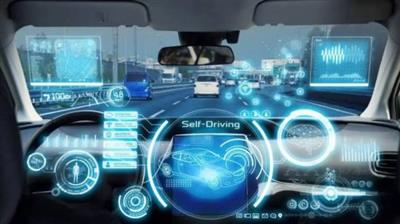
MP4 | Video: h264, 1280x720 | Audio: AAC, 44.1 KHz, 2 Ch
Genre: eLearning | Language: English + srt | Duration: 120 lectures (12h 38m) | Size: 5 GB
Learn OpenCV 4, YOLO, road markings and pedestrians detection, and traffic sign classification for self-driving cars
What you'll learn:YOLO
OpenCV
Detection with the grayscale image
Colour space techniques
RGB space
HSV space
Sharpening and blurring
Edge detection and gradient calculation
Sobel
Laplacian edge detector
Canny edge detection
Affine and Projective transformation
Image translation, rotation, and resizing
Hough transform
Masking the region of interest
Bitwise_and
KNN background subtractor
MOG background subtractor
MeanShift
Kalman filter
U-NET
SegNet
Encoder and Decoder
Pyramid Scene Parsing Network
DeepLabv3+
E-Net
YOLO
OpenCV
RequirementsBasic Python programming
DescriptionAutonomous Cars: Computer Vision and Deep Learning
The automotive industry is experiencing a paradigm shift from conventional, human-driven vehicles into self-driving, artificial intelligence-powered vehicles. Self-driving vehicles offer a safe, efficient, and cost effective solution that will dramatically redefine the future of human mobility. Self-driving cars are expected to save over half a million lives and generate enormous economic opportunities in excess of $1 trillion dollars by 2035. The automotive industry is on a billion-dollar quest to deploy the most technologically advanced vehicles on the road.
As the world advances towards a driverless future, the need for experienced engineers and researchers in this emerging new field has never been more crucial.
The purpose of this course is to provide students with knowledge of key aspects of design and development of self-driving vehicles. The course provides students with practical experience in various self-driving vehicles concepts such as machine learning and computer vision. Concepts such as lane detection, traffic sign classification, vehicle/object detection, artificial intelligence, and deep learning will be presented. The course is targeted towards students wanting to gain a fundamental understanding of self-driving vehicles control. Basic knowledge of programming is recommended. However, these topics will be extensively covered during early course lectures; therefore, the course has no prerequisites, and is open to any student with basic programming knowledge. Students who enroll in this self-driving car course will master driverless car technologies that are going to reshape the future of transportation.
Tools and algorithms we'll cover include:
OpenCV.
Deep Learning and Artificial Neural Networks.
Convolutional Neural Networks.
YOLO.
HOG feature extraction.
Detection with the grayscale image.
Colour space techniques.
RGB space.
HSV space.
Sharpening and blurring.
Edge detection and gradient calculation.
Sobel.
Laplacian edge detector.
Canny edge detection.
Affine and Projective transformation.
Image translation, rotation, and resizing.
Hough transform.
Masking the region of interest.
Bitwise_and.
KNN background subtractor.
MOG background subtractor.
MeanShift.
Kalman filter.
U-NET.
SegNet.
Encoder and Decoder.
Pyramid Scene Parsing Network.
DeepLabv3+.
E-Net.
If you're ready to take on a brand new challenge, and learn about AI techniques that you've never seen before in traditional supervised machine learning, unsupervised machine learning, or even deep learning, then this course is for you.
Moreover, the course is packed with practical exercises that are based on real-life examples. So not only will you learn the theory, but you will also get some hands-on practice building your own models. There are five big projects on healthcare problems and one small project to practice. These projects are listed below:
Detection of road markings.
Road Sign Detection.
Detecting Pedestrian Project.
Frozen Lake environment.
Semantic Segmentation.
Vehicle Detection.
That is all. See you in class!
"If you can't implement it, you don't understand it"
Or as the great physicist Richard Feynman said: "What I cannot create, I do not understand".
My courses are the ONLY course where you will learn how to implement deep REINFORCEMENT LEARNING algorithms from scratch
Other courses will teach you how to plug in your data into a library, but do you really need help with 3 lines of code?
After doing the same thing with 10 datasets, you realize you didn't learn 10 things. You learned 1 thing, and just repeated the same 3 lines of code 10 times...
Who this course is forBeginners who are starting to learn Computer Vision.
Undergraduate students who are studying subjects related to Artificial Intelligence.
People who want to solve their own problems using Computer Vision.
Students who want to work in companies developing Computer Vision projects.
People who want to know all areas inside Computer Vision, as well as know the problems that these techniques are able to solve.
Anyone interested in Artificial Intelligence or Computer Vision.
Data scientists who want to grow their portfolio.
Professionals who want to understand how to apply Computer Vision to real projects.
Software engineers interested in learning the algorithms that power self-driving cars.
Screenshots
Download link:
Só visivel para registados e com resposta ao tópico.Only visible to registered and with a reply to the topic.Links are Interchangeable - No Password - Single Extraction

